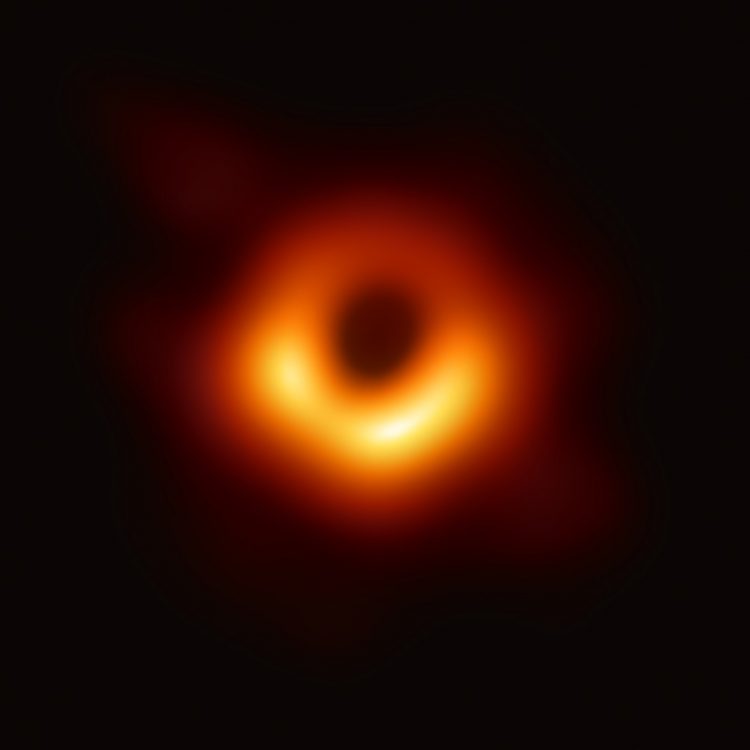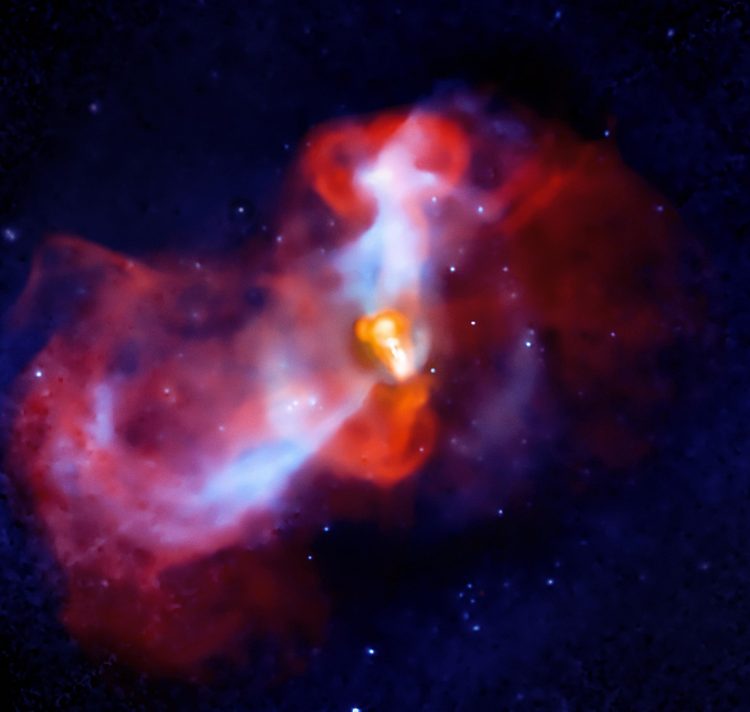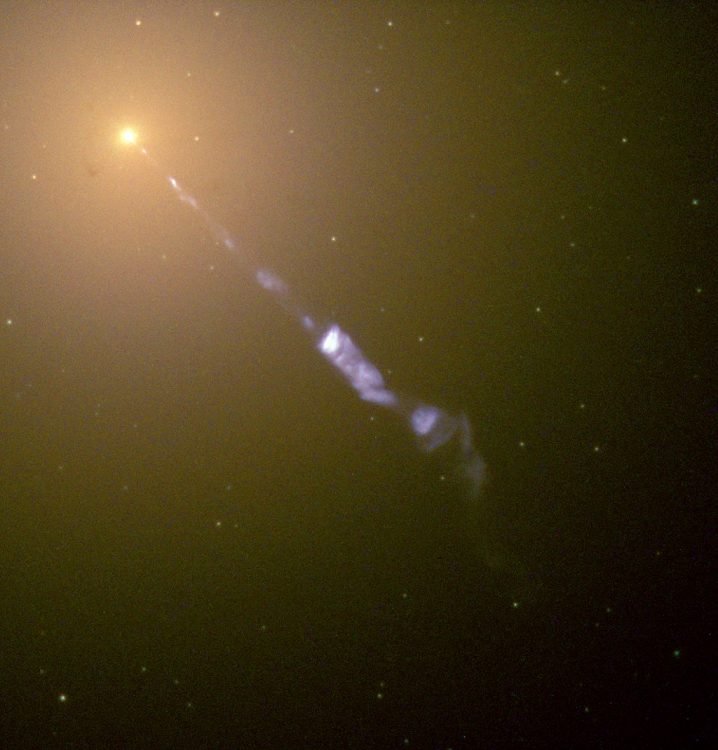Why the oohs and ahhs?
16 Apr 2019|Jeff Tseng
- Research

On 10 April 2019, the Event Horizon Telescope announced that it had taken a picture of a black hole – and there it was, looking a bit like a glow-in-the-dark coffee stain. Some were a bit underwhelmed.
Part of the disappointment arises from unfortunate comparisons. We’re used to dramatic artists’ impressions, not to mention Hollywood movies. But the new picture even suffers a bit when put next to NASA images showing ghostly plasma jets erupting out of the galactic core (see below and the Wikipedia page for a good selection). To be fair, one has to remember that these are composite images, often colouring in parts of the light spectrum we can’t see. In other words, if we ourselves looked through a telescope, no amount of magnification would yield those pictures to our eyes. Instead, we have to ‘improve’ our eyes by extending their sensitivity to more of the light spectrum – rather like the night-vision and thermal imaging devices in more everyday use. Indeed, the black hole picture itself is taken using yet another part of the light spectrum we can’t see; the array of radio telescopes, combined with algorithms and hours of computing time, is simply how we ‘see’ in that spectrum.
So what makes physicists go “ooh ahh” over a luminous coffee ring?
Some commentators have spoken of the incredible achievement of making the picture – both making the picture possible, and the data analysis behind the picture itself, led by Katie Bouman (it’s nice to see the role of graduate students acknowledged!). They aren’t exaggerating. There are also incredible distances and scales involved, along with a bit of luck in the properties of the black hole itself.
For me, however, admiration for the achievement goes along with standing in awe of the order of Nature itself. Science is like a huge leap into the unknown, with mathematics our principal guide leading us from the mundane to the unfamiliar and downright bizarre. The picture shows Nature at its most compellingly logical.

Let’s start with a relevant but utterly mundane example, a walk in the park with a companion. You give him a shove. Your shove’s effect on his motion will be related to his mass: the more massive he is, the less effect.
But let’s say he stumbles and falls instead. In this case, the force of the Earth’s gravity on him will be proportional to his mass. (Strictly speaking, gravity acts on him even as he remains upright, but the effect is less obvious.) So this single property, his mass, performs double duty, in two different sorts of physics, that of shoves, and that of gravity.
The distinction between these two roles might seem a rather fussy one, one easily dismissed with a shrug of the shoulders and “Why should I care?” But it became a key jumping-off point when Einstein sought to extend his theory of special relativity to include accelerating observers. It’s from this rather harmless-looking, somewhat pedantic beginning that Einstein worked out what we now call “general relativity”. Indeed, its first success might appear similarly modest and pedantic, in that it enabled Einstein to calculate the orbit of Mercury more accurately – a difference of about 0.01 degrees between then state-of-the-art observations and calculations based on Newton’s theory of gravitation.
Today, special and general relativity play a role in everyday life through satellite-based navigation systems; in fact, they’re essential to the accuracy of your GPS location. But even these are relatively small corrections, so in a sense the main surprise is that they play a role at all.
The fact that we get better corrections out of general relativity gives us some confidence that it works as a physical theory. Yet it comes with considerable overhead: its mathematical structure literally warps our notions of space and time. It’s a lot of heavy lifting if only for small adjustments. But there’s a lot more in the theory, and hiding in the labyrinth are some rather strange creatures. This is where one leaps into terra incognita (so to speak): the mathematical description is good for small corrections – does it work as well at the other extreme, where everyday experience gives us no aid?

Certainly one of the most exotic beasts lurking in this part of the mathematics is the notion of the black hole, a compact object of such large mass that light itself can’t escape its gravitational pull. We’re now so used to this idea even in popular culture that we forget that it took decades, and a lot of head-scratching and doubtful looks, for the idea to be established. (Some of its features are truly bizarre – I won’t get into them, but Kip Thorne’s lecture on black hole coordinate systems is the only lecture I’ve ever attended which seemed physically to disorient me, and I recall the next few days only as a sort of daze.)
On the other hand, the existence of a mathematical solution doesn’t imply that such solutions exist in Nature. While several mechanisms for producing a black hole have been proposed, one could ask, how could Nature tolerate something so extreme? Could some new, undiscovered physics interpose, disrupting or indeed taming it – turning it into something more humdrum?
As it turns out, recent years have given us a lot of reason to think there are black holes out there. The motion of stars around the center of the Milky Way, for instance, appear to be consistent with a black hole at its center. The 2015 observation of gravitational waves from the merger of two astrophysical bodies – itself an “ooh ahh” moment – made little sense unless one hypothesized that the two bodies were black holes.
But it’s something else to see an actual picture, a tiny dark shadow where something has extinguished the light of glowing, hot gas. We are a long way from speculating about two ways of defining a walking companion’s mass, or calculating corrections to Mercury’s orbit. And the required leap from there to here is a mathematical structure which can be profoundly disorienting. It’s like getting to the end of a long, bumpy journey, and finding your destination is everything you imagined it to be. Maybe even better.
So when I saw the picture, I thought: it’s true, it’s lovely, it’s admirable.
It’s an “ooh ahh”.
This article was originally published online on 12 April 2019 on Jeff’s blog, and is reproduced here with his permission.
Read more on our blog
Category: Research
Author

Jeff
Tseng
Jeff Tseng is a Professor of Physics and Tutorial Fellow and College Dean at St Edmund Hall. He is a particle physicist who usually studies neutrinos with the SNO+ experiment at SNOLAB in Canada, but has maintained an interest in general relativity, curved space-time, and the possibility of extra dimensions since his undergraduate years.

